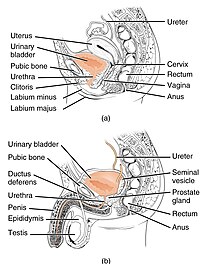
Photo from wikipedia
STUDY OBJECTIVE To demonstrate laparoscopic colposuspension for recurrent stress incontinence after failed tension-free vaginal tape (TVT). DESIGN A technical video showing laparoscopic colposuspension for previously surgically treated stress incontinence (Canadian… Click to show full abstract
STUDY OBJECTIVE To demonstrate laparoscopic colposuspension for recurrent stress incontinence after failed tension-free vaginal tape (TVT). DESIGN A technical video showing laparoscopic colposuspension for previously surgically treated stress incontinence (Canadian Task Force classification III). SETTING A university hospital. PATIENT A 58-year-old woman with previous TVT presents with recurrent stress urinary incontinence. MEASUREMENTS AND MAIN RESULTS Midurethral slings have equivalent cure rates to the more invasive colposuspension. They are preferentially used for stress urinary incontinence despite a mesh erosion rate of 3.5% with 2.5% requiring further surgery, sling removal, or revision over 9 years [1,2]. Recent negative publicity concerning synthetic mesh tape has led to a resurgence of interest in mesh-free alternatives, including urethral bulking agents, rectus fascia slings, and colposuspension. Laparoscopic colposuspension is a well-established minimally invasive surgery that avoids synthetic mesh, with a quicker recovery, less scarring, and equivalent success to an open approach [3]. Bladder neck mobility is an important marker during selection of this technique. In this video, we demonstrate our transperitoneal technique of colposuspension in the case of failed TVT. This technique allows clear visualization of the operating field and is faster and less bloody than a full dissection. Because complications can ensue from extensive excision and extraction, unless the previous TVT has caused problems such as pain, we normally leave it in situ. Careful dissection is undertaken into the Retzius space to the paravaginal tissues where the iliopectineal ligament is located. On each side, we apply 2 extracorporeally tied nonabsorbable Ethibond (Johnson and Johnson Medical NV, Bruxelles, Belgium) sutures as recommended [4], caudal and lateral to the TVT, lifting the paravaginal tissues to the ligament. The knot is placed on the ligament side to minimize erosion risk. The peritoneal defect is closed with a Vicryl 2.0 (Johnson and Johnson Medical NV) suture. This technique offers a viable mesh-free option for the treatment of recurrent stress incontinence in women who have had failed TVT.
Journal Title: Journal of minimally invasive gynecology
Year Published: 2019
Link to full text (if available)
Share on Social Media: Sign Up to like & get
recommendations!